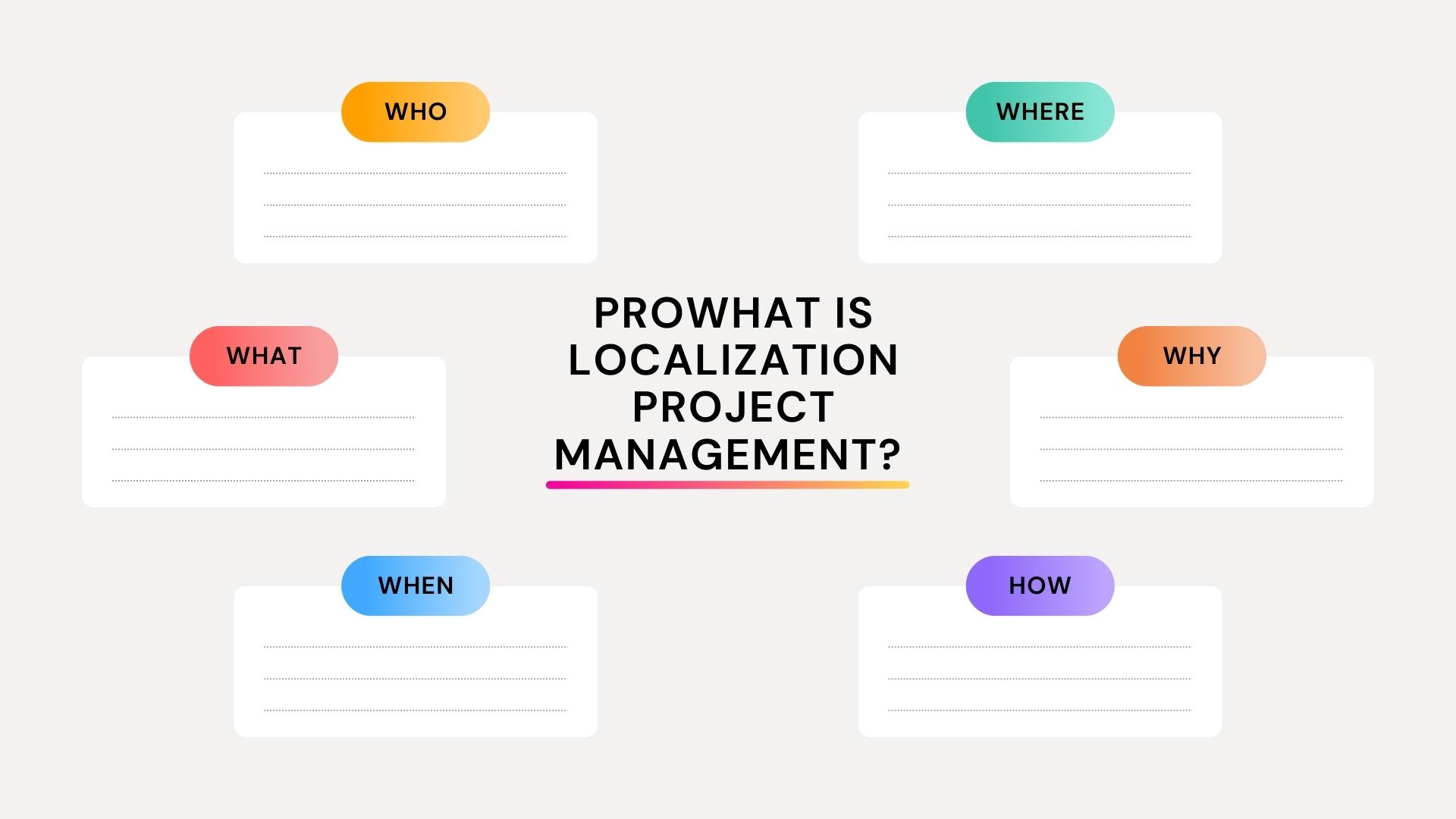
Expanding a business globally is a complex and strategic endeavor. It goes far beyond simply translating your website—every aspect of your product, marketing, and customer experience must be adapted to resonate with diverse international audiences. This holistic adaptation process is called localization, and it is critical for ensuring your brand feels natural, relevant, and trustworthy in each new market.
Successfully executing localization requires strong project management. Without a structured framework, projects can quickly encounter challenges such as budget overruns, missed deadlines, inconsistent messaging, and content that fails to engage the target audience. Coordinating multiple languages, cultural expectations, and technical requirements simultaneously demands a specialized skill set, meticulous planning, and close collaboration among translators, developers, marketers, and other stakeholders. Effective localization project management ensures that your global expansion is smooth, efficient, and strategically aligned with business objectives.
What is Localization Project Management?

Localization project management is the process of planning, executing, and overseeing all the tasks involved in adapting a product or content for a specific international market. It goes beyond simple translation to include cultural adaptation, technical adjustments, and quality assurance, ensuring the final product feels natural and authentic to local users.
A localization project manager orchestrates this entire effort. They are the central point of contact, coordinating the work of translators, developers, marketers, and legal experts. Their primary goal is to deliver a high-quality, localized product on time and within budget, while navigating the complexities of different languages and cultures.
Core Responsibilities of a Localization Project Manager
A successful localization project manager wears many hats. They are part strategist, part coordinator, and part quality controller. Their responsibilities are broad and critical to the project’s success.
Strategic Planning and Scoping
Before any translation begins, the project manager defines the project’s scope. This involves:
- Identifying Target Markets: Deciding which regions and languages to prioritize based on business goals and market research.
- Defining Deliverables: Clarifying what needs to be localized, from website content and user interfaces to marketing materials and legal documents.
- Setting Timelines and Budgets: Creating a realistic schedule and budget that accounts for all phases of the project.
- Assembling the Team: Selecting the right internal stakeholders and external vendors, such as translators, localization engineers, and in-country reviewers.
Resource and Vendor Management
Managing the human element is a huge part of the job. The project manager must:
- Source and Vet Translators: Find skilled linguists with subject matter expertise and experience in the target language and culture.
- Coordinate with Stakeholders: Keep internal teams, from marketing to engineering, aligned on goals and timelines.
- Manage Vendor Relationships: Build strong partnerships with language service providers (LSPs) and freelancers to ensure consistent quality and reliability.
Process and Technology Management
Modern localization relies heavily on technology. A project manager oversees the technical workflow, which includes:
- Implementing a Translation Management System (TMS): Using a TMS to automate workflows, manage translation memories (TMs), and maintain term bases (glossaries).
- Preparing Content for Localisation: Ensuring source content is finalised and formatted correctly for translation, a process known as internationalisation.
- Handling File Formats: Managing various file types and ensuring they are compatible with localisation tools.
Quality Assurance
Ensuring the final product meets high standards is paramount. The project manager is responsible for:
- Linguistic Quality Assurance (LQA): Implementing a review process where native speakers check for accuracy, tone, and cultural appropriateness.
- Functional Testing: Testing localized software or websites to ensure all elements display correctly and function as intended.
- Consistency Checks: Using translation memories and glossaries to maintain consistent terminology across all localized content.
The 6 Stages of the Localization Project Management Lifecycle

A well-structured localization project follows a clear lifecycle. Breaking the process down into distinct stages helps keep everything organized and on track.
1. Project Initiation and Planning
This is the foundational stage where you define the project’s goals. Key activities include conducting a project kickoff meeting, defining the scope, identifying stakeholders, estimating costs, and creating a detailed project plan. This plan should outline every task, deadline, and resource needed.
2. Preparation and Internationalization
Before translation can start, the source content and product must be prepared. This involves internationalization, which is the process of designing and coding a product so it can be easily adapted for various languages and regions without engineering changes. For content, this means finalizing the source text, creating a style guide, and developing a glossary of key terms.
3. Translation and Adaptation
With preparation complete, the actual translation work begins. The project manager assigns tasks to translators and provides them with all necessary resources, including the glossary, style guide, and translation memory. This stage isn’t just about word-for-word translation; it involves adapting content to fit cultural norms and local context.
4. Review and Quality Assurance
5. Functional Testing and Implementation
6. Project Closure and Post-Launch
The project doesn’t conclude once the localized product goes live. The closure and post-launch phase ensures that all processes are properly wrapped up and that valuable insights are captured for future projects. Key activities include:
Archiving Project Files: Organize and store all project-related files, including source content, translated materials, style guides, glossaries, and communication records. Proper archiving ensures easy retrieval for future reference or updates.
Updating Translation Memories and Glossaries: Incorporate the latest translations into the translation memory (TM) and update glossaries to maintain consistency in terminology for future projects. This step ensures efficiency and accuracy in subsequent localization efforts.
Conducting a Post-Mortem Meeting: Hold a team review to analyze project performance. Discuss what went well, challenges encountered, and areas for improvement. This meeting helps identify process optimizations and best practices for future localization projects.
Gathering Feedback from the Target Market: Collect insights from end-users in the localized market to assess cultural relevance, clarity, and overall quality. This feedback is invaluable for fine-tuning content and ensuring it resonates effectively with the audience.
Planning for Future Updates: Develop a roadmap for maintaining and updating localized content. This includes scheduling periodic reviews, implementing improvements based on feedback, and preparing for new content releases or software updates.
By meticulously executing the closure and post-launch phase, localization project managers ensure sustainability, maintain quality standards, and set the foundation for continued success in global markets.
Best Practices for Successful Localization Project Management
Following best practices can make the difference between a smooth project and a chaotic one. Here are some key principles to adopt:
Centralize Communication: Use a single platform, like a TMS or project management tool, to keep all communication and files in one place. This prevents confusion, ensures everyone is aligned, and streamlines collaboration across teams and vendors.
Invest in Technology: A robust Translation Management System (TMS) is essential for modern localization projects. It automates workflows, reduces manual work, maintains translation memory (TM) consistency, and enables terminology management, ensuring efficiency and accuracy throughout the project.
Create Detailed Style Guides and Glossaries: Provide linguists with comprehensive guidance on your brand’s tone of voice, preferred terminology, and words that should not be translated. This consistency is critical for maintaining brand identity and quality across multiple markets.
Prioritise Internationalisation: Incorporate internationalisation at the start of the product development lifecycle, not as an afterthought. Designing software and content with global adaptability in mind saves time, reduces costs, and minimizes rework later in the localization process.
Build a Strong Team: Collaborate with experienced, native-speaking translators who have expertise in your industry. Nurture long-term relationships with language partners and in-country reviewers to ensure high-quality output and cultural accuracy.
Don’t Skip the Review Step: In-country review is a crucial quality check. Local team members understand cultural nuances and market expectations, providing feedback that ensures the content resonates authentically with the target audience.
These principles help create a structured, efficient, and high-quality localization process, reducing errors, delays, and ensuring global consistency in brand messaging.
Paving the Way for Global Success

Effective localization project management is the engine that drives successful global expansion. It provides the structure, strategy, and oversight needed to navigate the complexities of entering new markets. By understanding the core responsibilities of a localization project manager, following a structured project lifecycle, and adopting industry best practices, you can ensure your products and content connect authentically with audiences worldwide.
Moreover, effective localization project management allows businesses to anticipate potential challenges and implement solutions proactively, rather than reacting to issues as they arise. It ensures consistency in brand messaging, user experience, and product functionality across multiple regions and languages. This organized approach helps prevent miscommunication, misaligned expectations, and costly rework, which are common pitfalls when expanding internationally.
Taking a strategic and organized approach to localization doesn’t just prevent costly mistakes; it builds a strong foundation for international growth, allowing your brand to thrive on a global scale. It empowers teams to work efficiently, reduces turnaround times, and maximizes return on investment for international projects. By integrating technology, skilled personnel, and structured workflows, companies can maintain high quality while scaling operations globally. Ultimately, strong localization project management not only facilitates smooth market entry but also strengthens customer trust, enhances brand reputation, and ensures long-term competitive advantage in the global marketplace.
FAQ – Localization Project Management
Q1: What is localization project management?
A1: It is the process of planning, coordinating, and overseeing all activities required to adapt products or content for specific international markets, including translation, cultural adaptation, technical preparation, and quality assurance.
Q2: How is localization different from translation?
A2: Translation focuses on language conversion, while localization also considers cultural relevance, formatting, legal requirements, and user experience to ensure content feels native to the target market.
Q3: What does a localization project manager do?
A3: They manage timelines, budgets, teams, vendors, technology, and quality checks, acting as the central point of coordination to ensure projects are delivered accurately and on time.
Q4: What tools are commonly used in localization projects?
A4: Translation Management Systems (TMS), translation memory tools, terminology databases, QA tools, and project management platforms are commonly used.
Q5: Why is internationalization important before localization?
A5: Internationalization ensures products and content are designed to support multiple languages and regions, reducing rework, costs, and technical issues during localization.
Q6: How is quality ensured in localization projects?
A6: Through linguistic quality assurance (LQA), in-country reviews, functional testing, and consistency checks using glossaries and translation memories.
Q7: What are common challenges in localization project management?
A7: Managing multiple languages, tight deadlines, cultural nuances, technical constraints, and maintaining brand consistency across markets.
Leave a Reply